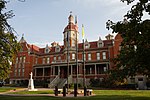Kearns-St. Ann's Orphanage
Buildings and structures in South Salt Lake, UtahNational Register of Historic Places in Salt Lake County, UtahResidential buildings on the National Register of Historic Places in UtahSchool buildings completed in 1890School buildings on the National Register of Historic Places in Utah ... and 1 more
Utah Registered Historic Place stubs

The Kearns-St. Ann's Orphanage, at 430 East 2100 South in South Salt Lake, Utah, was built in 1890. It was designed by architect Carl M. Neuhausen. Later serving as Kearns-Saint Ann Catholic School, it was listed on the National Register of Historic Places in 1980. According to its NRHP nomination, the orphanage is significant partly for its architecture, with "modest decorative elements allud[ing] to Renaissance and Mannerist" styles, representing "the important educational and religious contributions to Utah society of Bishop Lawrence Scanlan and Thomas and Jennie Kearns".: 4
Excerpt from the Wikipedia article Kearns-St. Ann's Orphanage (License: CC BY-SA 3.0, Authors, Images).Kearns-St. Ann's Orphanage
2100 South, Salt Lake City
Geographical coordinates (GPS) Address Phone number Website Nearby Places Show on map
Geographical coordinates (GPS)
| Latitude | Longitude |
|---|---|
| N 40.725 ° | E -111.87805555556 ° |
Address
Kearns-Saint Ann Catholic School
2100 South 430
84115 Salt Lake City
Utah, United States
Open on Google Maps











